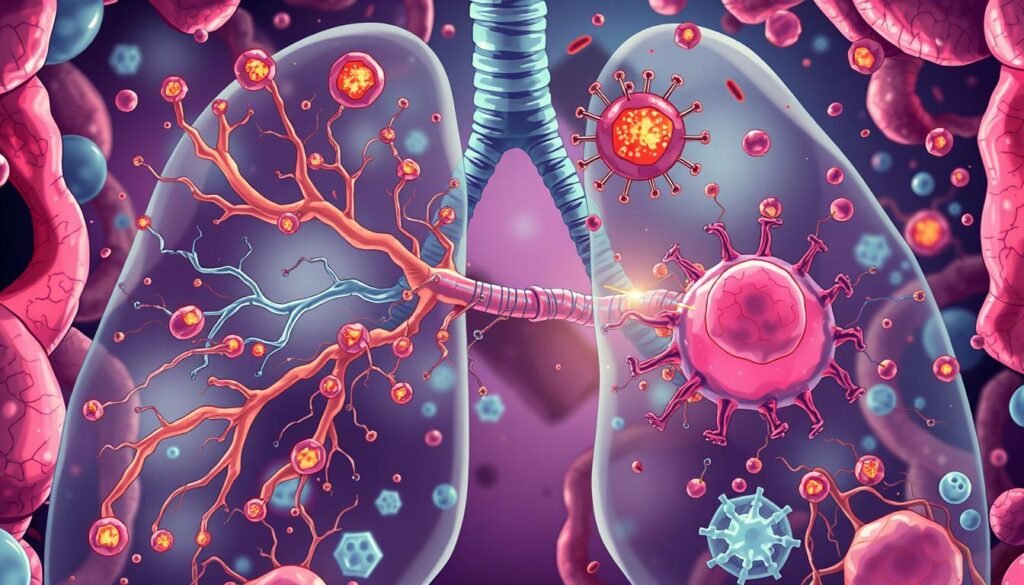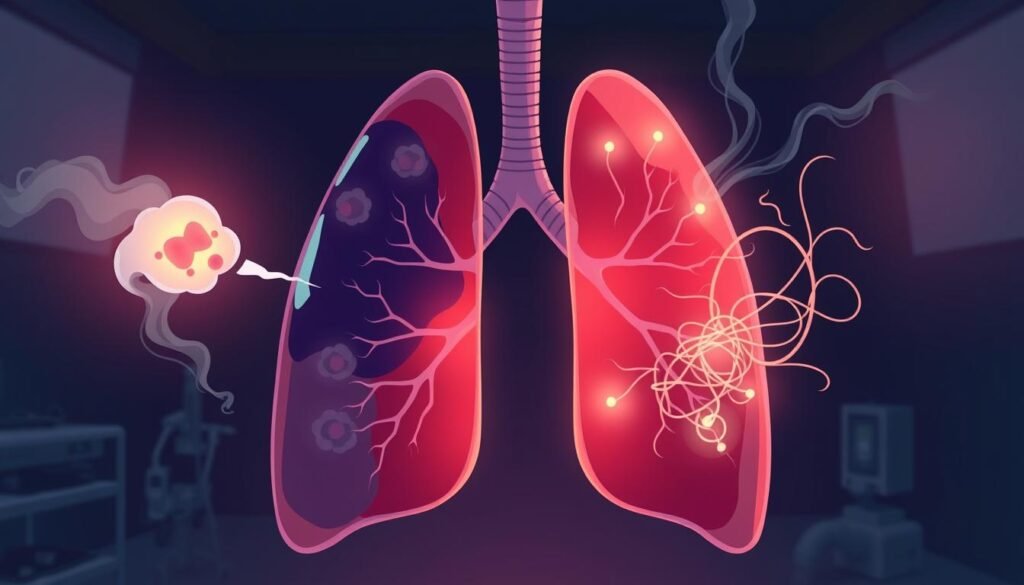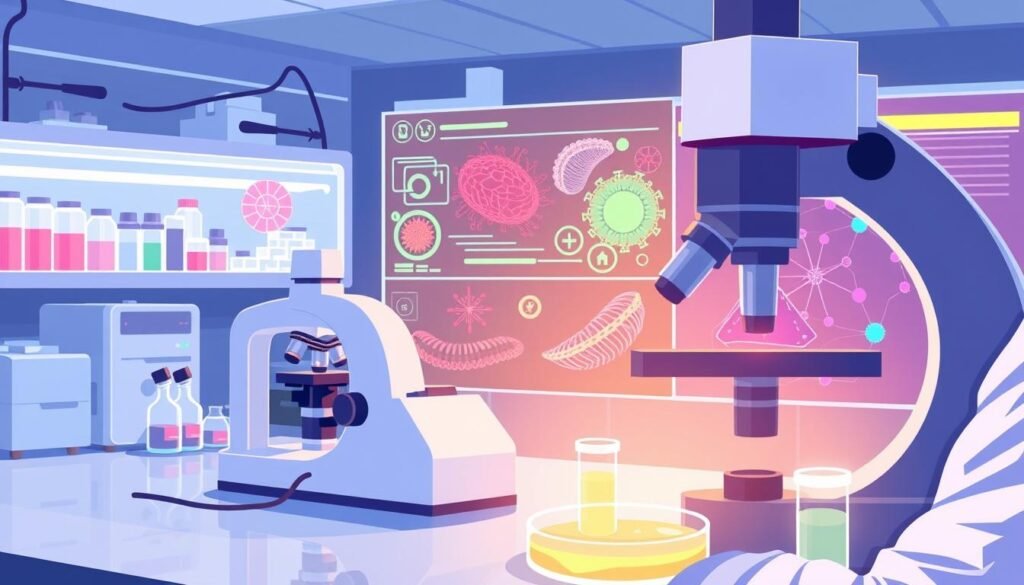Lung cancer causes nearly 28% of all cancer deaths in the U.S. This fact shows why it’s crucial to understand how lung cancer grows. Knowing about the growth of cancer cells in the lungs helps with diagnosis, treatment, and research in pulmonary oncology.
Lung cancer starts when normal cells in the lungs change due to genetic issues. It’s vital to find and treat lung cancer early because it usually doesn’t show symptoms until it’s advanced. There are many kinds of lung cancer, including NSCLC and SCLC. Knowing the differences between them can improve treatment success.
If you want to learn more about lung cancer, check out the guide from Lungevity. It’s important for patients, their families, and doctors to know about risk factors, how to diagnose it, and treatment options.
Key Takeaways
- Lung cancer is the leading cause of cancer deaths globally.
- Early detection can greatly impact treatment success rates.
- There are two main types of lung cancer: NSCLC and SCLC.
- Genetic factors and exposure to carcinogens significantly influence lung cancer risk.
- Symptoms often surface only when the disease reaches an advanced stage.
The Importance of Understanding Lung Cancer
Lung cancer is a major public health issue, amounting to 12.4% of all new cancer cases globally. It’s key to know these stats to fully understand the impact of this illness. Lung cancer is the top cause of cancer deaths worldwide because it’s often found late.
Statistics and Prevalence of Lung Cancer
In the US, lung cancer has the highest death rate among cancers. Each year, 85,600 men and 71,340 women die from it. Around 239,320 new cases were recorded in 2010, showing how widespread lung cancer is.
About 15% of lung cancer cases are small cell lung cancer (SCLC). The other 85% are non-small cell lung cancer (NSCLC), mostly in people with adenocarcinoma. The average age at diagnosis is 71, with about 29% of cases in those aged 75-84. It’s vital for older adults to know lung cancer’s signs and symptoms.
The Need for Early Detection and Treatment
Spotting lung cancer early is key to better survival rates. Early screening helps find cancer sooner, greatly improving chances of survival. People with cancer found early have a 52% chance of surviving five years, far better than the 3.6% for advanced cases. This shows why we must raise awareness about early detection.
New treatments like immunotherapy have changed lung cancer care. Personalized treatment plans give patients the best chance at fighting the disease. Strategies such as understanding the particular traits of lung are also important.
| Statistic | Value |
|---|---|
| New Lung Cancer Cases (2010) | 239,320 |
| Annual Lung Cancer Deaths (Men) | 85,600 |
| Annual Lung Cancer Deaths (Women) | 71,340 |
| 5-Year Survival Rate (Localized) | 52% |
| 5-Year Survival Rate (Distant) | 3.6% |
Types of Lung Cancer
Knowing the different types of lung cancer is key to the right diagnosis and treatment. There are mainly two types: non-small cell lung cancer and small cell lung cancer. Each type has its own set of characteristics, affects treatment differently, and has a different outlook.
Non-Small Cell Lung Cancer (NSCLC)
Non-small cell lung cancer makes up about 80-85% of all lung cancer cases. It is split into several subtypes, each with its own traits:
- Adenocarcinoma: The most common subtype of NSCLC, usually found in the outer parts of the lung. It starts in the cells that make mucus in the airway lining.
- Squamous Cell Carcinoma: This kind begins in the flat cells lining the airways. It’s often located near the center of the lung, close to a bronchus.
- Large Cell Carcinoma: Known for its large cancer cells, this aggressive subtype can form anywhere in the lung.
There are other, rarer types of non-small cell lung cancer like adenosquamous carcinoma and sarcomatoid carcinoma. NSCLC also includes unique forms such as Pancoast tumors and mesothelioma. Pancoast tumors affect the lung’s top area. These special cases have their own treatments, which may include chemo, radiation, or surgery.
Small Cell Lung Cancer (SCLC)
Small cell lung cancer represents about 15-20% of lung cancer cases. It’s strongly linked to cigarette smoking. This cancer type grows and spreads fast, so catching it early is vital. Despite its aggressive nature, there are treatments specifically aimed at it.
https://www.youtube.com/watch?v=ihCnDjyJv5c
The Process of Malignant Cell Growth in the Lungs
Studying lung cancer, we focus on how cancer cells grow in the lungs. This is complicated, involving many factors. Among these, genetic changes in lung cells’ DNA are crucial. Mutations in genes like TP53, EGFR, and KRAS make cells grow uncontrollably and resist death. This leads to cancer.
Genetic and Epigenetic Changes
Genetic mutations are key in lung cancer. They often happen as cells adapt to harmful environments like tobacco smoke. These mutations cause genetic changes that help cancer cells survive and multiply. This knowledge helps us find treatments that target these specific mutations.
Field Cancerization Explained
The idea of field cancerization explains more about lung cancer. It means lots of lung tissue changes after long exposure to harmful stuff, not just a few cells. This can lead to many areas in the lungs turning cancerous. So, it’s important to keep an eye on people at risk, especially those who’ve smoked a lot or been around harmful air.
| Type of Change | Description | Impact on Cancer Development |
|---|---|---|
| Genetic Changes | Mutations in genes like TP53, KRAS | Leads to unchecked cell proliferation |
| Field Cancerization | Broad tissue alteration due to carcinogen exposure | Increases risk of multiple cancerous transformations |
| Epigenetic Changes | Alterations in gene expression without changing DNA sequence | Affects cellular behavior and may promote malignancy |
Key Molecular Mechanisms in Lung Cancer Development
It’s key to know how lung cancer starts to find good treatments. Lung cancer comes from issues in cell signals that cause unchecked growth. How cell growth and stopping signals interact affects how tumors grow.
Cell Growth Signals and Anti-Growth Signals
Cell growth signals are crucial in how lung cancer forms. Tumors get what they need to grow through new blood vessel formation. Also, ignoring stop signals breaks normal controls on cell growth. This lets cancer cells multiply unchecked. So, it’s important to understand these molecular mechanisms for new treatments.
Apoptosis Evasion and Replicative Potential
Lung cancer cells can often dodge programmed cell death, or apoptosis evasion. This dodging helps them live longer and replicate. They don’t get killed off by our immune system. This leads to more growth and spread. So, how these cells dodge death shows us targets for treatment.

Role of Carcinogens in Lung Cancer
To fight lung cancer, we must understand carcinogens’ role. Tobacco smoke is a major contributor to lung cancer. This section looks at the damage from tobacco smoke and how environment and job factors might also affect lung cancer risk.
Tobacco Smoke and Its Damage
Tobacco smoke has over 5,000 compounds, with 73 known carcinogens. Cigarette smoking causes about 85% of lung cancer cases. It leads to 90% of the 1.37 million lung cancer deaths worldwide each year.
Secondhand smoke also harms, increasing non-smokers’ lung cancer risk by 15-30%. Certain chemicals in tobacco, like N-nitrosodiethylamine (DEN) and benzo[a]pyrene (BaP), can cause cancer. Studies show women might be more affected by tobacco smoke than men.
Environmental and Occupational Factors
Environment plays a big part in lung cancer risk. Things like air pollution and nitrogen dioxide increase the risk. Radon gas is the second biggest cause of lung cancer in the US.
Working with carcinogens like asbestos raises lung cancer risk, especially when mixed with tobacco smoke. It’s key to know about these risks and prevent them. Public health efforts to lower cigarette use and environmental dangers can cut lung cancer rates a lot.
Signs and Symptoms of Lung Cancer
Finding lung cancer early can make treating it much more effective. Knowing the symptoms helps with getting checked out sooner. This could be key for beating the disease.
Common Early Warning Signs
Some people might start to see signs of lung cancer early on. But, not everyone notices them until it’s more advanced. Early signs to be aware of include:
- Persistent cough
- Coughing up blood
- Chest pain
- Hoarseness
- Loss of appetite
- Unexplained weight loss
- Shortness of breath
- Fatigue
- Frequent infections
- Wheezing
Spotting these early could mean a big difference in treatment options. Acting quickly can help improve life quality and outcomes.
Advanced Symptoms of Lung Cancer
When lung cancer gets worse, symptoms can be more intense and varied. People may deal with:
- Bone pain because of cancer spreading
- Nervous system changes, messing with how you move or balance
- Jaundice, showing liver issues
- Swelling of lymph nodes in different places
- Pancoast tumor symptoms, like weak eyelids and less sweating
- Superior vena cava syndrome, causing swelling in the face and arms
Paraneoplastic syndromes may also appear, affecting the body in various ways. Knowing these signs can help doctors and patients act fast.

Diagnosis of Lung Cancer
To diagnose lung cancer, doctors start with a full medical history and physical exam. They look for risk factors and symptoms linked to lung cancer. This step is key in identifying if lung cancer might be present.
Medical History and Physical Exams
Healthcare providers review details like past symptoms, family cancer history, and exposure to risks during the medical history assessment. In the physical exam, doctors search for signs like a hoarse voice or strange lung sounds. This thorough check-up is vital for creating a diagnosis plan.
Imaging Tests and Biopsies
After reviewing your medical history and conducting a physical exam, imaging tests become crucial. They help spot lung tumors and their stages. Chest X-rays and CT scans are common and show detailed lung images. If something suspicious is seen, a biopsy is needed.
During a biopsy, doctors take a small piece of lung tissue to look for cancer cells. Imaging and biopsies together give a full picture of your condition. This ensures doctors can plan the best treatment.
| Diagnostic Method | Purpose | Procedure |
|---|---|---|
| Medical History | Identify risk factors and symptoms | Discussion with healthcare provider |
| Physical Exam | Check for visible signs of cancer | Hands-on examination by the physician |
| Imaging Tests | Visualize lung structure and detect abnormalities | CT scans, chest X-rays |
| Biopsies | Confirm presence of cancer | Tissue sampling via bronchoscopy or needle biopsy |
Treatment Options for Lung Cancer
Finding the right treatment for lung cancer depends on the cancer type and stage. Non-small cell lung cancer (NSCLC) is more common than small cell lung cancer (SCLC). Each has its own treatment methods. Good treatments can really help patients feel better and live longer.
Surgery and Resection Techniques
Surgery is key for treating early-stage NSCLC. Doctors may remove the tumor and some tissue around it. Methods like lobectomy, segmentectomy, and wedge resection are used. If the cancer is at stage 0, surgery might be all that’s needed. This means patients won’t need chemotherapy or radiation.
For bigger or spread-out tumors, adding chemotherapy before surgery can help.
Chemotherapy and Targeted Therapies
Chemotherapy is often used for advanced lung cancer. It attacks fast-growing cancer cells. Alongside chemotherapy, there’s targeted therapy. It focuses on the cancer’s specific genetic changes. For example, if a patient’s cancer has certain mutations, they may get personalized medicine. This can improve their chances against advanced cancer.
Radiation Therapy and Immunotherapy
Radiation therapy is common in lung cancer treatment. It’s sometimes used after surgery or as the main treatment for small cell lung cancer. Techniques like Stereotactic Body Radiation Therapy and Intensity-Modulated Radiation Therapy target tumors accurately. Immunotherapy tries to get the body’s immune system to fight the cancer. Using radiation and immunotherapy together can lead to better treatment results. To learn more, check out this resource.
Understanding Metastatic Tumors
Lung cancer is known for its ability to spread. This makes metastatic lung cancer complex to understand. It can spread to the liver, brain, or bones, for example. Knowing how it moves helps doctors stage the disease and plan treatment.
How Lung Cancer Spreads Through the Body
Lung cancer mainly spreads through blood or lymph fluids. It moves from where it started to other organs. This means the cancer is at a more advanced stage, making treatment harder.
It often spreads to the bone, liver, brain, and adrenal glands.
- Bone
- Liver
- Brain
- Adrenal glands
Knowing where lung cancer typically spreads helps catch symptoms early. These symptoms can be different based on where the cancer has moved to.
- Pain and fractures in bones
- Headaches, seizures, or dizziness in the brain
- Shortness of breath in the lungs
- Jaundice or swelling in the belly for liver involvement
Distinguishing Between Primary and Secondary Tumors
It’s vital to tell primary and secondary tumors apart in lung cancer. Primary tumors start in the lungs. Secondary, or metastatic tumors, appear when cancer from another place, like the breast or prostate, spreads. This distinction affects how doctors plan treatment and predict outcomes.
| Primary Tumors | Secondary Tumors |
|---|---|
| Begin in the lungs, like adenocarcinoma or squamous cell carcinoma | Move from other body parts, like breast, prostate, or pancreatic cancers |
| Found through imaging and biopsy | Needs a look at past cancer diagnoses |
| Treatable locally | Treating areas where cancer has spread |
By grasping the details of primary and secondary, experts can create specific care plans. They aim to improve the outcomes for those with metastatic lung cancer.
The Role of Biomarker Testing in Treatment Planning
Biomarker testing is key in planning treatments for lung cancer. It finds specific genetic changes. This lets doctors make individualized treatment plans.
These plans focus on each patient’s unique cancer traits. This custom approach improves treatment results. It also reduces side effects that are not needed.
Identifying Genetic Mutations for Targeted Therapies
Spotting certain genetic changes allows doctors to use targeted therapies. These are designed for specific types of cancer. For example, EGFR inhibitors show how well precision medicine works against lung cancer.
Advances in biomarker testing include different tests like genomic testing. These help doctors choose treatments matching a patient’s genetic makeup. The NCI-MATCH study shows how biomarker testing is changing cancer care by finding the best therapies for different genetic profiles.
The Importance of Individualized Treatment Plans
Biomarker testing helps select effective treatments. It’s very important for making individualized treatment plans. This testing reveals genetic changes that could impact cancer risk.
With this information, healthcare teams offer exact advice. Biomarker tests like liquid biopsies are suggested for people with advanced cancer. This is especially true for those with non-small cell lung cancer.
Personalized treatments lead to better care. They give people fighting lung cancer the highest chance of a good outcome.

Lung Cancer Research and Future Directions
New progress is being made in lung cancer research. This opens doors to new treatments and better results for patients. Researchers are working hard to understand lung cancer better. They’re also creating targeted therapies to increase survival rates.
Ongoing Clinical Trials and Innovations
Clinical trials are key to finding new lung cancer treatments. The National Cancer Institute (NCI) supports many trials. These trials look at different approaches, like low-dose CT screening for those at high risk. Such screening is good at finding lung cancer early. This gives patients a better chance to beat it.
New research uses machine learning to improve CT scans. This technology is very accurate at spotting cancer. These advances could really change how we diagnose and treat lung cancer.
Emerging Therapies and Their Impact
New treatments are making a big difference. For example, drugs like alectinib and osimertinib help patients with a certain type of lung cancer live longer without their disease getting worse. Also, immunotherapies such as nivolumab and pembrolizumab are now options right from the start. They work better than chemotherapy alone for some patients.
These new therapies target specific genetic changes. They are also customized for each patient. This shows a move towards treatments designed for each person, known as personalized medicine.
Research into lung cancer is very promising. Thanks to clinical trials and new treatments, we’re getting better at fighting this disease. Patients are seeing real benefits from these advances.
Conclusion
Understanding how lung cancer cells grow and develop is key to better patient outcomes in the U.S. It’s the top cause of cancer deaths among both genders, with about 25% of all cancer deaths. Knowing the details of this disease is crucial.
This overview shows us many insights into how cancer cells grow. It talks about the discovery of over 257 genes that play a role in cancer growth. This shows why it’s so important to keep researching to improve treatments.
The way lung cancer, especially small cell lung cancer (SCLC), spreads shows why we need effective treatments. People with SCLC have a lot of tumor cells moving through their bloodstream, making their situation worse. But, with the FDA-approved CellSearch© system, we can find these cells better. This can help doctors treat lung cancer more effectively.
Identifying these tumor cells early helps in planning better treatments for patients. This leads to more hope for beating the disease.
Research into lung cancer treatment is ongoing and promising, especially studies on using electric fields to manage tumors. Creative treatments and customized care plans are crucial for fighting lung cancer. For more info on lung cancer research and strategies, check out this resource. It offers great insights for patients and health professionals.